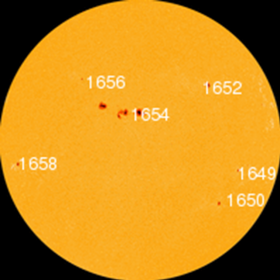Giant solar spot AR1654 appeared On January 8, 2013 on the solar disc did not produce as many intensive solar flares as the scientists had expected, Irina Myagkova, Senir researcher of the Division of Operative Space Moitoring told.
Solar spot is a agnetically concentrated region on the Sun. This region looks more dark because it is relatively colder than the neighbour regions: 4226,85ºC (Т=4500К) comparing with 5526,85ºC (Т=5800 К). Large groups of solar spots can produce powerful solar flares whose radiation can in turn influence on th magnetosphere and ionosphere of the Earth.
A giant solar spot AО1654 was several thousands kilometers in diameter - much larger than the Earth. The spot moved across the solar disc during approximately 14 days as befits, i.e. till January 22. It situated at the central meridian of the Sun on January 14.
Its giant size and configuration specific for the appearence of solar flares lead to the forecasts of sharp increasing of flare activity which eventually did not come true. During the period of the region AR 1654 situation at the visage of the Sun three flares of M-class in soft X-radiation have happened. Two of them took place on January 11 in AR 1654, and the third one in the smaller active region AR 1652.
Solar cosmic rays from the flares produced by AR 1654 have not been observed. Instead solar protons with rather soft spectrum (up to 10 MeV) came to the Earth on the night of January 16/17 were produced by the flare of just C2.2 class which had happened in the active region AR 1650 declined outside south-western limb.

